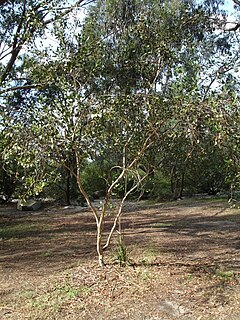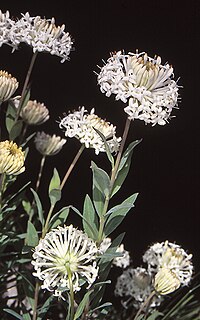
Eucalyptus platypus, also known as moort or maalok, is a species of mallee or marlock that is endemic to the southwest of Western Australia. It has smooth bark, broadly elliptical to more or less round adult leaves, flower buds in groups of nine on a broad, flattened peduncle, usually creamy white flowers and conical, down-turned fruit.

Pimelea linifolia, commonly known as slender rice flower is a common, variable shrub widespread throughout eastern Australia. It has narrow leaves arranged in opposite pairs, and usually white flowers arranged in heads of seven or more on the ends of the stems, with four lance-shaped bracts at the base of the inflorescence. The plant may be toxic to livestock.

Pimelea flava is a shrub in the family Thymelaeaceae which is endemic to Australia.

Olearia phlogopappa commonly known as the dusty daisy-bush or alpine daisy-bush is a species of flowering plant in the family Asteraceae. Commonly found in eastern New South Wales, Victoria and Tasmania. It is a small shrub with greyish-green foliage, daisy-like flowers in white, pink or mauve from spring to late summer.

Pimelea octophylla, commonly known as woolly riceflower or downy riceflower, is a shrub in the family Thymelaeaceae. The speciesis native to south-eastern Australia. It grows up to 1 metre high and produces cream to pale yellow terminal flowerheads with long white hairs. The flowerheads have 25 to 150 flowers. The leaves are 2 to 15 mm long and 0.5 to 5 mm wide.

Persoonia asperula, commonly known as mountain geebung, is a plant in the family Proteaceae and is endemic to south-eastern Australia. It is an erect or prostrate shrub with smooth bark, mostly elliptic to oblong leaves and yellow flowers borne singly or in groups of up to nine. It mostly occurs in the Southern Highlands of New South Wales. A small population in Victoria may be a different species.

Eucalyptus verrucata, commonly known as Mount Abrupt stringybark, is a species of shrub or a small tree that is endemic to the Grampians in Victoria, Australia. It has smooth bark, rough bark on the base of older trees, egg-shaped to elliptical adult leaves, flower buds usually singly in groups of three in leaf axils, white flowers and cup-shaped or hemispherical fruit.
Eucalyptus × alpina, commonly known as Grampians gum, is a mallee or small tree that is endemic to the Grampians in Victoria, Australia. It has fibrous grey bark near its base and smooth greyish bark higher up. The leaves are broadly lance-shaped to egg-shaped and the plant has very warty buds and fruit. There is disagreement about its name, the Royal Botanic Gardens Victoria referring to it as the Mt Abrupt stringybark.

Eucalyptus serraensis, commonly known as the Grampians stringybark, is a species of small tree or mallee that is endemic to the Grampians in Victoria, Australia. It has rough, stringy, fibrous or flaky bark on the trunk and sometimes also the branches, smooth bark above, lance-shaped to egg-shaped or round adult leaves, sessile flower buds in groups of three or seven, white flowers and hemispherical or cup-shaped fruit.
Eucalyptus victoriana is a species of small to medium-sized tree that is endemic to the Grampians in Victoria, Australia. It has rough, stringy bark on part of the trunk, egg-shaped to lance-shaped adult leaves, flower buds in groups of seven to eleven, white flowers and cup-shaped to hemispherical fruit.
Eucalyptus impensa, commonly known as the Eneabba mallee, is a species of straggly mallee that is endemic to a small area of Western Australia. It has smooth bark, dull, light green, egg-shaped to broadly lance-shaped leaves, flower buds arranged singly in leaf axils, pink flowers and relatively large, flattened hemispherical fruit.

Pimelea glauca, commonly known as smooth riceflower, is a species of small shrub in the family Thymelaeaceae and is endemic to Australia. It is not considered to be threatened.

Pimelea pauciflora, commonly known as poison rice-flower, is a species of shrub in the family Thymelaeaceae. It has small yellow-lime flowers, green, smooth fleshy leaves and is endemic to Eastern Australia.

Acacia provincialis, commonly known as swamp wattle or wirilda or water wattle or perennial wattle, is a tree or shrub belonging to the genus Acacia and the subgenus Phyllodineae native to southern and south eastern Australia.
Eucalyptus purpurata, commonly known as the Bandalup silver mallet, is a species of mallet that is endemic to a small area in the southwest of Western Australia. It has smooth, silvery bark, glossy dark green, lance-shaped adult leaves, flower buds in groups of between seven and eleven, creamy white flowers and shortened spherical fruit.

Eucalyptus semiglobosa is a species of mallee or small tree that is endemic to the south coast of Western Australia. It has smooth bark, broadly lance-shaped adult leaves, flower buds in groups of seven, creamy white flowers and ribbed or wrinkled, shortened spherical or hemispherical fruit.

Pimelea treyvaudii, commonly known as grey rice-flower, is a species of shrub in the family Thymelaeaceae. It has white flowers in spherical heads at the end of branches and is endemic to eastern Australia.

Pimelea aeruginosa is a species of small shrub in the family Thymelaeaceae. It is a small shrub with yellow flowers and is endemic to Western Australia.

Pimelea ammocharis is a species of small shrub in the family Thymelaeaceae. It is a small shrub with white-yellow to orange flowers and is endemic to Western Australia.

Pimelea angustifolia, commonly known as narrow-leaved pimelea, is a small upright, slender or open shrub with whitish, cream, yellow or pink flowers. It is endemic to Western Australia.















